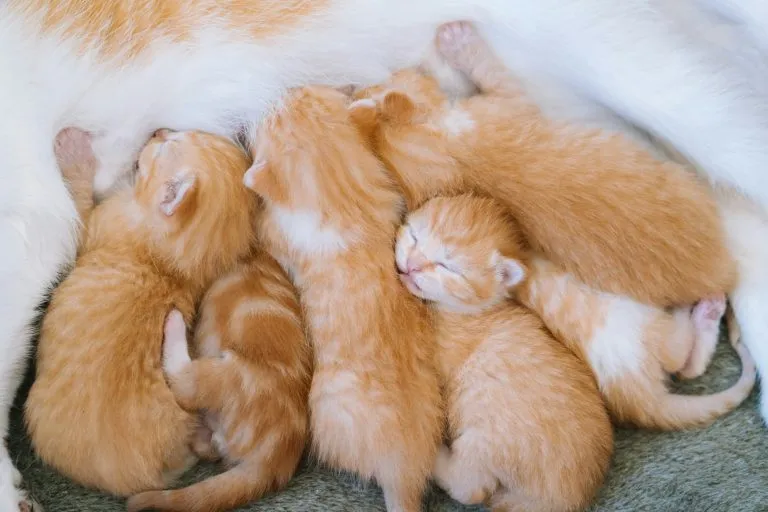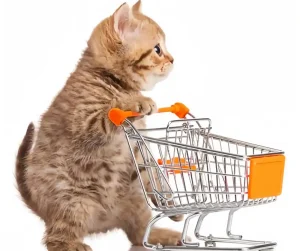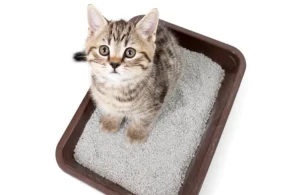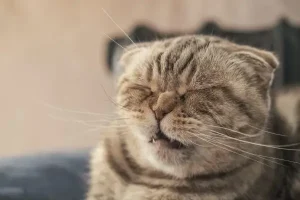Table of contents
- What’s the dust concentration in a good cat litter?
- What’s the deodorizing effect in a good cat litter?
- What’s the formaldehyde concentration in a good cat litter?
- How much crushed powder is present in a good cat litter?
- What’s the clumping water absorbency of a good cat litter?
- What’s the clumping strength of a good cat litter?
- How well does a good cat litter adhere to the bottom of the litter box?
- What’s the water absorption of a good cat litter?
- What are the monthly costs of using a cat litter?
How to choose a good cat litter?
The most comprehensive way to evaluate cat litter!
15 years of cat litter producer experience sharing!


When I first brought the kitten home, it felt like the start of a delightful love story.
I couldn’t resist sharing it with everyone.
The way it sleeps is absolutely adorable. Its eyes are like rare gems.
The sound of its little meows is so sweet, that it melts my heart.

However, few people reveal the “dark side” of owning cats.
They can often be impatient, playing nicely one moment, but catching you off guard the next. They’re picky eaters, sometimes refusing all cat food and canned food, leaving you worried sick. They’re prone to jealousy, expressing displeasure by urinating or defecating on the bed.
Most importantly, you have to endure the smell of cat poop and urine every day.
When you have just one cat, it’s manageable, and the odor isn’t so noticeable. But once you add a second cat, the smell in your home doubles. You’re enveloped in the scent of cat poop and urine every day, making you too embarrassed to invite friends over. It’s like living in hell, especially with five cats!
Rows of litter boxes are placed against the wall, and the smell when you come home every day can almost make you faint. Since then, you’ve been searching for various deodorizing products every day. You’ve tried everything from deodorizing beads to sprays—covering, absorbing, and decomposing odors.
Finally, you realize that various deodorizing products only provide temporary relief, and the mixture of their scent with the foul odor is simply unbearable! The most crucial factor is the effectiveness of the cat litter!
Instead of indulging in buying cat litter deodorizing products, it’s better to switch to good cat litter.

I will analyze what makes a good cat litter from the perspective of a cat litter manufacturer.
Additionally, I will provide relevant information on testing cat litter performance.
I will introduce them one by one from the following aspects:
What's the dust concentration in a good cat litter?
Firstly, the dust concentration of the cat litter is considered. When PM2.5 exceeds 115 micrograms per cubic meter (μg/m3), cats may experience sneezing and coughing. The higher the concentration, the stronger the irritation, and it may also lead to respiratory diseases such as asthma and bronchitis.
Test Methods
We pour the newly opened cat litter into the litter box from a height of 60cm and place an air purifier next to the litter box. We use the air purifier to measure the dust concentration, specifically PM2.5 levels (in μg/m3), generated during the pouring process.
Testing qualification standard: PM2.5≤115 μg/m³

What's the deodorizing effect in a good cat litter?
The lower the concentration of ammonia in the cat litter’s urine, the better its deodorizing ability. Conversely, higher concentrations of ammonia can be highly corrosive and irritating to the eyes and respiratory systems of humans and cats. This may cause symptoms such as redness, swelling, watery eyes, coughing and sneezing. In severe cases, various inflammations such as rhinitis, pharyngitis, tracheitis, bronchitis, and even asthma may occur.
Test Methods
The temperature was maintained at 25°C (±1) and the humidity at 50% (±2%). In a glass container 30 cm long, 18 cm wide and 20 cm high, spread 10 cm thick cat litter. Pour 30ml of ammonia solution with a concentration of 0.5%, seal it for 3 minutes and check the ammonia concentration, and measure the value at a distance of 10cm from the center of the container.
Testing qualification standard: Ammonia content≤23.36ppm【20mg/m³】

What's the formaldehyde concentration in a good cat litter?
let’s consider the formaldehyde test. Excessive inhalation of formaldehyde poses significant risks to both humans and cats. It’s difficult to prevent cats from licking their paws or eating cat litter. Additionally, inhaling formaldehyde becomes more likely in poorly ventilated spaces. Therefore, this aspect demands the highest attention. Regardless of the formaldehyde concentration, any presence of it renders the product unqualified.
Test Methods
The temperature is maintained at 25°C (±1), with humidity at 50% (±2%). In a glass container measuring 30cm in length, 18cm in width, and 20cm in height, we lay down 10cm thick cat litter. After sealing the container for one hour, we measure the value at a distance of 10cm from the center of the container.
Testing qualification standard: Formaldehyde content is 0.

How much crushed powder is present in a good cat litter?
When there’s a higher amount of broken powder during cat litter usage, it indicates that the cat litter is more prone to breakage. This leads to increased dusting, poorer clumping, more residue, and a shorter usage cycle. Additionally, it not only irritates the respiratory tract but also results in more footprints being tracked around. For cats that enjoy licking their paws, it may also lead to gastrointestinal issues.
Test Methods
We took 2.5kg of newly opened cat litter. We placed it in the litter box. Then, we shook the litter box vigorously 10 times. Finally, we checked the amount of broken cat litter and powder left on the bottom of the litter box.
Testing qualification standard: Small amount of powder.

What's the clumping water absorbency of a good cat litter?
In view of the water-absorbing characteristics of cat litter, cat litter that absorbs water quickly can quickly form a cake-shaped sand clump, and the thickness of the clump should not exceed 5 cm. For a cat weighing 8-10 pounds, the average urine volume each time is about 30 ml. The better the cat litter absorbs water, the faster and flatter the clumps will clump. It is not easy to stick to the bottom when used, and cat claws are not easy to stick to poop.
Test Methods
Spread a 10 cm thick layer of cat litter in a glass container measuring 30 cm in length, 18 cm in width, and 20 cm in height. Pour 30 ml of water into the container and let it sit for one minute. Afterward, remove the block of cat litter and measure the depth of the clumps.
Testing qualification standard: Clumping depth≤5cm.

What's the Clumping strength of a good cat litter?
The lower the clumping strength, the easier it is for a cat to break the clumps when they step on the litter. This not only makes cleaning difficult but also accelerates the powdering and stinking of the entire litter box. This leads to the growth of odors and bacteria. Increasing the frequency of replacement causes waste.
Test Methods
Freely drop the sand mass obtained from the clumping water absorbency test from a height of 60cm, and weigh the weight of the sand mass with the largest integrity. Clumping strength = weight of the most complete sand mass/original weight of the sand mass.
Testing qualification standard: Clumping strength≥75%.

How well does a good cat litter adhere to the bottom of the litter box?
If your cat litter depth exceeds 8cm, you can skip this step as it’s already sufficient. However, if it’s lower, observe how the litter adheres to the bottom after absorbing water. Adhesion and residue in cat litter can greatly impact the scooping experience. When the litter tightly sticks to the bottom of the litter box and breaks easily, it speeds up litter decomposition, leading to unpleasant odors and bacterial growth.
Test Methods
Spread 1.5cm deep cat litter in the cat litter box, pour 30ml of water within 10 seconds, and let it sit for 30 minutes to test the difficulty of eradicating it.
Testing qualification standard: Cat litter is slightly sticky.

What's the water absorption of a good cat litter?
On average, a cat weighing 8-10 pounds urinates about 3 times and defecates once per day. The cat litter needs to absorb approximately 120 milliliters of water. The higher the absorption rate, the higher the utilization rate of the cat litter, which is also one of the most important factors determining the cost-effectiveness of the cat litter.
Test Methods
Place a 10 cm layer of cat litter in a glass container 30 cm long, 18 cm wide and 20 cm high. Pour 30ml of water into the container and let sit for a minute. Then, remove the cat litter block and measure the water absorption.
Water absorption rate = water weight/(total weight of clumped cat litter-water weight)
Testing qualification standard: Water absorption ≥66%.

What are the monthly costs of using a good cat litter?
A cat weighing 8-10 pounds typically urinates about 3 times and defecates once per day. The cat litter needs to absorb approximately 120 milliliters of water daily, totaling 3.6 kilograms per month.
The total monthly usage of cat litter is calculated by dividing 3.6 kilograms by the absorption rate. Monthly expenses are determined by multiplying the weight of cat litter used by the unit price per kilogram.
For example, if 8.2 kilograms of cat litter is priced at $18 with a unit price of $2.2 per kilogram, assuming an absorption rate of 45%, the monthly usage of cat litter would be 3.6 / 0.45 = 8 kilograms. Therefore, the monthly expenses would be 2.2 * 8 = $17.6.







